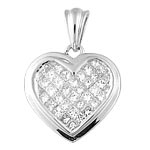|
|
 |
| Explaining the Mohs Scale |
| Oct-29-2007 |
Ask the average jewelry buyer who Friedrich Mohs is, and they will quickly rack their brain trying to remember the name of their salesperson. Not to worry, you have not made a social faux pas. Friedrich Mohs was a German mineralogist who devised a method of comparing the scratch resistance of minerals back in the 1800's. Why is that important you, the average buyer? Well, gemstones are minerals and therefore ranked on this scale according to durability. Keeping in mind that when you are buying a gift for someone (or even a little something for yourself), you want to buy something that not only looks nice, but something that will last a long time. A basic understanding of the hardness of minerals will save you headaches in the long run.
First of all, Friedrich Mohs devised this scale based upon a very basic test. He took ten easily found minerals and arranged them in  order of what will and what won't scratch each other. It is as simple as that. If a mineral can be scratched, it is softer; if it cannot, it's harder. And so the rank of 1-10 was developed; ten listed as the hardest mineral, the diamond, and one listed the softest, talc. Does that mean that a diamond is ten times more durable than talc? Surprisingly, no. The scale is less of a scale and more of a table. Meaning, the durability difference between a ranking of a 8 compared to a 9 is different than a ranking of a 9 compared to a 10. Simply put, the diamond (a 10) is not harder than a ruby (a 9) by a difference of one; a diamond is many times harder than a ruby, there is simply no mineral that ranks in between them. order of what will and what won't scratch each other. It is as simple as that. If a mineral can be scratched, it is softer; if it cannot, it's harder. And so the rank of 1-10 was developed; ten listed as the hardest mineral, the diamond, and one listed the softest, talc. Does that mean that a diamond is ten times more durable than talc? Surprisingly, no. The scale is less of a scale and more of a table. Meaning, the durability difference between a ranking of a 8 compared to a 9 is different than a ranking of a 9 compared to a 10. Simply put, the diamond (a 10) is not harder than a ruby (a 9) by a difference of one; a diamond is many times harder than a ruby, there is simply no mineral that ranks in between them.
Where do your favorite gems rank? If you have ever wondered what the big deal was surrounding the importance of diamonds, it will be no surprise to you to find out that diamonds rank at the top of the hardness scale. A great number of factors figure in to why diamonds are the ultimate symbol of love and beauty, one of which is the symbolism of the hardest naturally occurring substance in the world interlaced with the idea of one's devotion possessing the same unyielding properties.

A number nine on Mohs scale is corundum, more commonly known as sapphire and ruby. Many are surprised to find out that these two different gems have the same mineral properties. Sapphires are not just blue; in fact, corundum is found in a wide variety of colors, most of which are referred to as sapphire, while only red corundum is called ruby.
Another gem available in a wide variety of colors is topaz, number 8 on Mohs scale. Commonly available in yellow-brown and blue, topaz can also be green, pink, orange, and even colorless. In fact, there is no such thing as naturally occurring blue topaz. What you see as blue topaz in the stores is actually topaz which has been heat treated to turn them blue.
Another common precious gem, the emerald, has a unique place on Mohs scale at a 7.5 to 8 hardness level. As you look around a jewelry store, you may begin to wonder why an emerald is more expensive than a topaz, a gem that is more durable. The answer is simple; the highest naturally occurring emerald will be more expensive than a diamond because of its rarity, which is why more affordable synthetic emeralds are being developed. Emeralds are considered high on the hardness scale because of their resistance to scratching; however, natural emeralds are in fact brittle stones and should be treated more gingerly.
There are innumerable amounts of quartz varieties which fall at a level 7 on the scale. Common gems included in this group are amethyst and citrine. Opal is also a variety of quartz, but it is a hydrated, solidified quartz gel, which is why it is not faceted for jewelry purposes, but appears domed in shape.
When buying a gem, consider the Mohs scale as a great reference tool. Does it mean that you should shy away from a gem based upon it's placement on the scale? Certainly not. But understanding the scale will help you make an educated decision about what to buy based upon how you wear and how you care for your jewelry. |
|
|
Posted by Kim G at 12:28 PM - Link to this entry Share this entry |
| < Back to Diamonds Archives |
|
 |
|
|
|